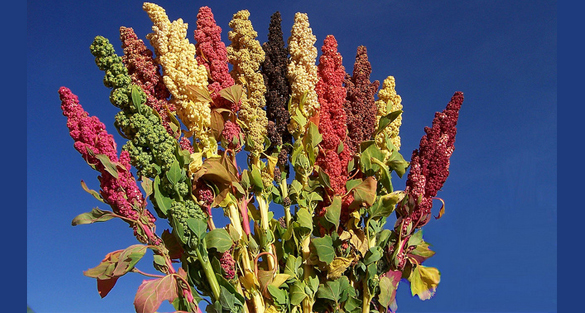LAUNCH OF THE INTERNATIONAL YEAR OF QUINOA: UN celebrates Andean “super food”
Quinoa can play an important role in eradicating hunger, malnutrition and poverty, FAO Director-General José Graziano da Silva said today at the official launch of the International Year of Quinoa at UN Headquarters.
UN Secretary-General Ban Ki-moon, President Evo Morales of Bolivia and First Lady Nadine Heredia Alarcón de Humala of Peru were among the high-level participants in a day-long series of events celebrating the Andean “super food”, a highly nutritious, cereal-like crop that is rich in protein and micronutrients.
“Today we are here to recruit a new ally in the fight against hunger and food insecurity –quinoa,” said Graziano da Silva, citing the crop’s unique nutritional characteristics and adaptability.
Quinoa is the only plant food that has all the essential amino acids, trace elements and vitamins, and also has the ability to adapt to different ecological environments and climates. Resistant to drought, poor soils and high salinity, it can be grown from sea level to an altitude of four thousand meters and can withstand temperatures between -8 and 38 degrees Celsius.
As the world faces the challenge of increasing the production of quality food to feed a growing population in a changing climate, quinoa offers an alternative food source for those countries suffering from food insecurity.
In Kenya and Mali, the crop is already showing high yields, the Director-General said, and initial FAO studies indicate that quinoa production could also be developed in the Himalayas, the plains of northern India, the Sahel, Yemen and other arid regions of the world.
Gift from the Andes
“This extraordinary grain has been a cultural anchor and a staple in the diet of millions of people throughout the Andes for thousands of years,” UN Secretary-General Ban Ki-moon said. “Quinoa is now poised for global recognition.”
The Secretary-General also highlighted the potential role of quinoa within the framework of his Zero Hunger Challenge, not only because of its nutritional value but also because most quinoa is currently produced by smallholder farmers.
“The crop holds the promise of improved incomes – a key plank of the Zero Hunger Challenge,” Ban said.
He noted that many countries in South America are making strong progress toward meeting the Millennium Development Goal of reducing hunger by half, not only by increasing production, but also by reducing poverty and increasing access to nutritious food like quinoa.
Quinoa was of great nutritional importance to pre-Colombian Andean civilizations, second only to the potato. Traditionally, quinoa grains are roasted and then made into flour for bread. It can also be cooked, added to soups, used as a cereal, as pasta and even fermented into beer or chicha, the traditional drink of the Andes.
Today, quinoa has found a place in the gourmet kitchen and a role in the pharmaceutical and other industries. Cultivation of quinoa now extends beyond the Andean region and – besides Bolivia, Peru, Ecuador, Chile, Colombia and Argentina – it is also produced in the United States, Canada, France, the United Kingdom, Sweden, Denmark, Italy, Kenya and India.
“Quinoa is an ancestral gift of the Andean people,” President Morales said, highlighting the important role of indigenous people as custodians of the crop for more than 7000 years.
Photo: Bioversity International
Nutritional value
The consumption of quinoa is becoming increasingly popular among people wanting to improve and maintain their state of health by changing their eating habits, as it is an excellent ‘functional food’ (which helps reduce the risk of various diseases and/or promotes good health). Because of its superior nutritional characteristics this food can be very useful in the different stages of human development and growth. Apart from being easy to digest, it has no cholesterol and is easy to use in the preparation of comprehensive and balanced diets.
Quinoa can also be used in both normal and vegetarian diets, as well as in the preparation of special diets for specific consumer groups such as the elderly, children, high-performance athletes, diabetics, celiacs and people with intolerance to lactose.
Proteins
What distinguishes quinoa is its high protein value. The quality and balance of its proteins is superior to that of other cereals, fluctuating between 12.5 and 16.7%. And 37% of quinoa proteins are made up of essential amino acids.
Essential amino acids are those that the human body cannot produce and that must therefore be ingested from the diet. A deficiency of these amino acids in the diet restricts human development as the cells of dead tissues cannot be repaired or new tissues created, in the case of growth. The essential amino acids for humans are : Valine, Leucine, Threonine, Lysine, Tryptophan, Histidine, Phenylalanine, Isoleucine, Arginine and Methionine.6
The amino acids that quinoa contains in greater quantities than other cereals are: glutamic acid, aspartic acid, isoleucine, lysine, phenylalanine, tyrosine and valine. Glutamic acid is involved in the production of energy for the brain and in key processes such as learning, memorization and neuronal plasticity; aspartic acid enhances liver function and is vital for maintaining the cardiovascular system; tyrosine has an important antistress function and plays a fundamental role in alleviating depression and anxiety, among other functions; lysine, whose content in quinoa is double that in other cereals, enhances the immunity function by helping build antibodies, favours the gastric function, collaborates in tissue repair, participates in the metabolism of fatty acids, helps the transfer and absorption of calcium, and can even, it would seem, delay or block – together with vitamin C – cancer metastasis, to mention only a few of its many therapeutic properties. As for isoleucine, leucine and valine, these participate together in the production of muscular energy, improve neuromuscular disorders, prevent liver damage and help maintain a balance of sugar levels in the blood, among other functions.
Fats
The majority of quinoa fats are monounsaturates and polyunsaturates which are beneficial to the body when incorporated into food, as they are fundamental in forming the structure and functionality of the human nervous and visual system. At the same time, their consumption reduces total cholesterol level and cholesterol LDL (bad cholesterol) in the blood, just to mention some of the multiple benefits to the human organism of consuming omega fatty acids. Fatty acid values in a raw quinoa grain are 8.1%, 52.3%, 23% of omega 3, omega 6 and omega 9 respectively.
Fibre
Quinoa is a food rich in fibre with a composition that varies according to type of grain, ranging from 2.49 to 5.31g/100 gr of dry matter. It has been shown that dietary fibre reduces levels of total cholesterol, LDL cholesterol and arterial pressure, and that it acts as an antioxidant. Antioxidants protect us from free radicals that cause the ageing processes and from other diseases.
Gluten free
Quinoa is considered to be gluten free as it contains less than 20mg/kg according to the Codex Alimentarius, rendering it useful for people allergic to gluten. A regular consumption of quinoa helps celiacs regain normality of the intestinal villi far more quickly than with a simple gluten-free diet.
Minerals
A quinoa grain contains virtually all minerals at a higher level than cereals. It contains phosphorous, calcium, iron, potassium, magnesium, manganese, zinc, lithium and copper.
Its iron content is twice that of wheat, three times that of rice and almost that of bean.
It has 1.5 times more calcium than wheat. This mineral is responsible for various bone and dental structure functions and also plays a role in regulating the neuromuscular transmission of chemical and electric stimuli, cell secretion and blood coagulation. The recommended calcium intake for children aged 4 to 9 years is 600-700 mg/day and for adults is from 1000 to 1300 mg/day (FAO/WHO, 2001).
Calcium is absorbed by the body due to the concurrent presence of zinc, which makes it highly recommended to, for example, avoid decalcification and osteoporosis, in contrast to other foods that indeed contain calcium but in which the calcium cannot be absorbed by the body. The zinc content of quinoa is twice that of wheat, and the differences are even greater when compared to rice and maize.
Vitamins
Quinoa has a high content of the vitamins of the B, C and E complex, with a vitamin B and C content higher than that of wheat. It is rich in beta-carotene and niacin (B3). It contains substantially more riboflavin (B2), alpha-tocopherol (vitamin E) and carotene than wheat and rice.
Source: 2013 International Year of Quinoa Secretariat
Activity: IV Global Congress on Quinoa, 8-12 July, 2013












